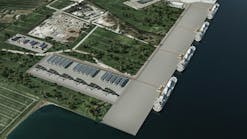Westinghouse Electric Company and Worley's Chemetics Sign MoU for Nuclear New-Build Projects
Westinghouse Electric Company and Worley’s Chemetics have signed a memorandum of understanding (MoU) to support both conventional and small modular reactor nuclear new-build projects in Canada and globally.
Under the agreement, Chemetics will design and fabricate alloy or carbon steel vessels and heat exchangers for key AP1000 and AP300 projects. AP300 is Westinghouse’s small modular reactor (SMR) design, while the AP1000 is a utility-scale pressurized water reactor which has been in operation at numerous sites worldwide, including in China (pictured).
“Joining forces enables Westinghouse and Worley Chemetics to address the intricate challenges of energy transition while enhancing nuclear opportunities across Canada,” said Andrew Barr, President of Worley Chemetics. “This partnership extends our 60-year history of delivering sustainable process technologies, supported by our recent ASME nuclear certification and our specialized alloy fabrication facility in Ontario.”
The Chemetics fabrication facility in Pickering, Ontario offers engineering, procurement and construction (EPC) services, including module fabrication and assembly and field-construction services across western Canada.
The Energy Revolution: What do you think?
Give EnergyTech your Feedback on Key Challenges
Westinghouse Electric Co. will provide Generation III+ reactor technology to be deployed in Canada and generate electricity by as early as 2035. A four-unit AP1000 facility in Canada is expected to power about three million homes, while supporting $20.39 billion in gross domestic product during construction and $5.75 billion in GDP annually in ongoing operations.
The four-unit project is anticipated to create 12,000 Canadian jobs and provide opportunities to Canadian firms to support more than 30 AP1000 units in the pipeline globally.
“Partnering with Canadian suppliers like Chemetics drives real economic benefits for the national economy by employing local trades and creating jobs for nuclear new build projects in Canada and internationally,” said John Gorman, President of Westinghouse Canada. “For each AP1000 unit we build around the world, Westinghouse could generate almost $1 billion of Canadian dollars in GDP through local suppliers.”
Nuclear energy reactors produce electricity without carbon emissions. They offer baseload power with high capacity factor capabilities and are more flexible than intermittent renewable energy generation.
SMRs are considered a future phase of smaller reactors which can be adapted to power industrial sites and data centers, among other customers.
Powering Data Centers with Microgrids and SMRs
New Microgrid Knowledge White Paper from Xendee





